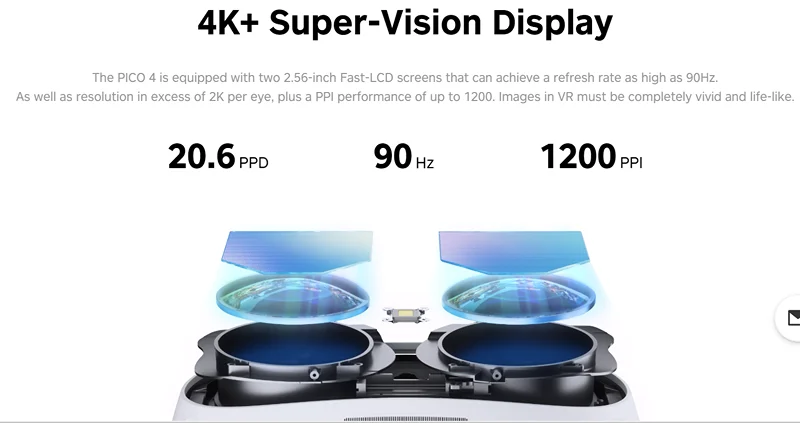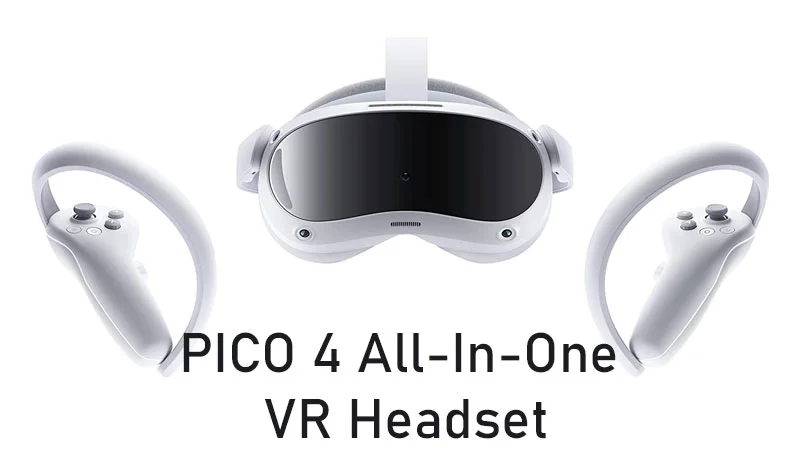The Pico 4 is a Bytedance launched by TikTok’s parent company on September 27th globally. It is the first competitor to Meta’s 2-year-old Quest 2 VR headset (formerly Facebook). In the next few years, you can also take them as a positive sign of standalone VR headsets. Eventually, you can also see more hardware options.
To be known: Pico 4 wasn’t approachable in the US, but in Asian & European markets, it’s highly priced, related to the Quest 2. Whereas it overtakes it. The Pico 4 represents the Quest 2-like:
- Responsive controllers (that use AA batteries)
- Qualcomm Snapdragon XR2 processor
- library of games and apps
These three effectively support overlaps with the best titles the Quest 2 has.
It consists of a few upgrades. But it has a few drawbacks, too. Let’s look-up the best information in-detail as per certain headings.
Pico 4 Specs
Regarding the specification perspective, its components are at least as good as what Meta offers. You even have the option to gear with an additional 2GB of RAM (for 8GB total), a higher-resolution 2,160 x 2,160 pixels/eye display, and a color passthrough that can provide you with an efficient mixed-reality experience.

Furthermore, it supports the sport’s comfier design to fetch a premium look. Finally, it evenly distributes the weight when you wear it on your head; the rather front-heavy design includes Oculus Quest 2. As a result, though Pico 4 is 83g heavier than the Quest 2, it feels lighter and calmer to wear.
Price and Availability
The Pico 4 is valued at 429 euros for the 128GB model and 499 euros for the 256GB version. Unfortunately, it won’t be available in the US, but the starting price adapts to roughly $425, £375, or AU$ 640. In contrast, this undercuts the Meta Quest 2, which initiates from $400 (or 450 euros) for similar storage options.
The headset is accessible in 13 European countries, including Japan and Korea, at first. However, ByteDance doesn’t have any approaches to announcing the Pico 4 in the US for the future, rather picking the business-focused pro-level version with eye tracking arriving next year that might compete with the Meta Quest Pro.
The Pico 4 (left) is smaller in the front than the Quest 2 (right). Eventually, the battery moves to the larger back strap.
Display and Design
It has a slimmed-down Pico 4 headset design. Here, this can be used as a new type of pancake lens (which can also be utilized as Meta’s new Quest Pro). However, even this can shrink down the front of the headset.
The Pico 4 still gives you the best feel, like VR goggles, but it’s remarkably more comfortable to wear on your face. Unfortunately, about the Quest 2, the foam-covered headset eyepiece might fit over extra-wide glasses. Rather than that, you may fall in love with the fit of the Pico 4.
Battery Specifications
A battery on its back is the completely adjustable head strap which balances weight out more, allowing the headset to rest lightly on my head. Whereas the Quest 2- in comparison, is connected with the support of an elastic head strap which feels less comfy but more compact while using.
Additionally, you have one add-on head strap, with Meta’s Elite Strap, that is closer to the Pico design. Finally, whereas the headset slides can help you turn on and off effortlessly, with the front casting up a bit, you might feel deep into the VR much faster when compared to Quest 2.
On the other hand, the headset’s LCDs have a 2,160×2,160-pixel resolution per eye. But, in most apps, you might find it hard to notice much difference. The refresh rate can incline up 90Hz if you allow it in the settings, but it might not allow 120Hz like Quest 2. In addition, the field of view of this particular headset is wider than the recent model. Therefore, you can expect the best of all modes, from 105 degrees. As a result of this, the panoramas in games can give you the feel of a little less like you’re gazing, and you will love the look.
Here, the passthrough cameras display your surroundings on the headset with higher resolution and full color when compared. Eventually, Pico 4 has a similar draw-your-play-area boundary setup that can be utilized with the headset, and any big mixed reality applications remain.
Games on Pico 4
The Fruit Ninja game on the Pico app store has a passthrough-enabled mode. On the other hand, the VR features didn’t line up with the actual world, which is just layered on top.
The Pico 4 charges through the stable USB-C, and battery life is predictable to be around two to three hours. So, you can expect a good approach for your usage.
The Pico 4 controller (left) has the same button layout as Quest 2 (right), and full motion tracking works the same.
Controllers
The given controllers consist of the same button layout, including
- Two raised buttons,
- Two flat buttons.
These are analog sticks and consists of two grip triggers. An elevated plastic ring above the controller allows tracking with the headset’s built-in cameras, but the position of the ring is quite different, arcing down as a replacement for up in a loop.
The controllers use two AA batteries, each with the best battery-life support. Vibrating haptics in the controllers occasionally feel punchy, as per the recent arrivals, but not as comprehensive or accurate as on the forthcoming Quest Pro and PlayStation VR 2.
We can play high-speed games, including Eleven Table Tennis and Space Pirate Trainer, smoothly to make an effortless gaming experience.
FAQ’s
How does the PICO 4 work?
When you wear the PICO 4, it takes only one simple click to deal with any ‘interference’ reference to the real world. You even have more MR apps to look forward to. For example, the PICO OS 5.0 Sports Centre participates in the proprietary CalSense physical fitness monitoring algorithm, which computes calorie consumption as you exercise in real-time.
